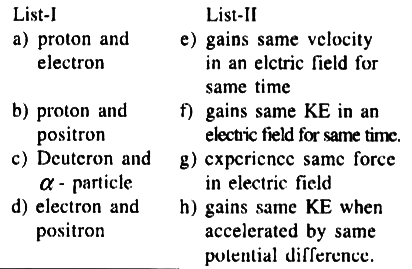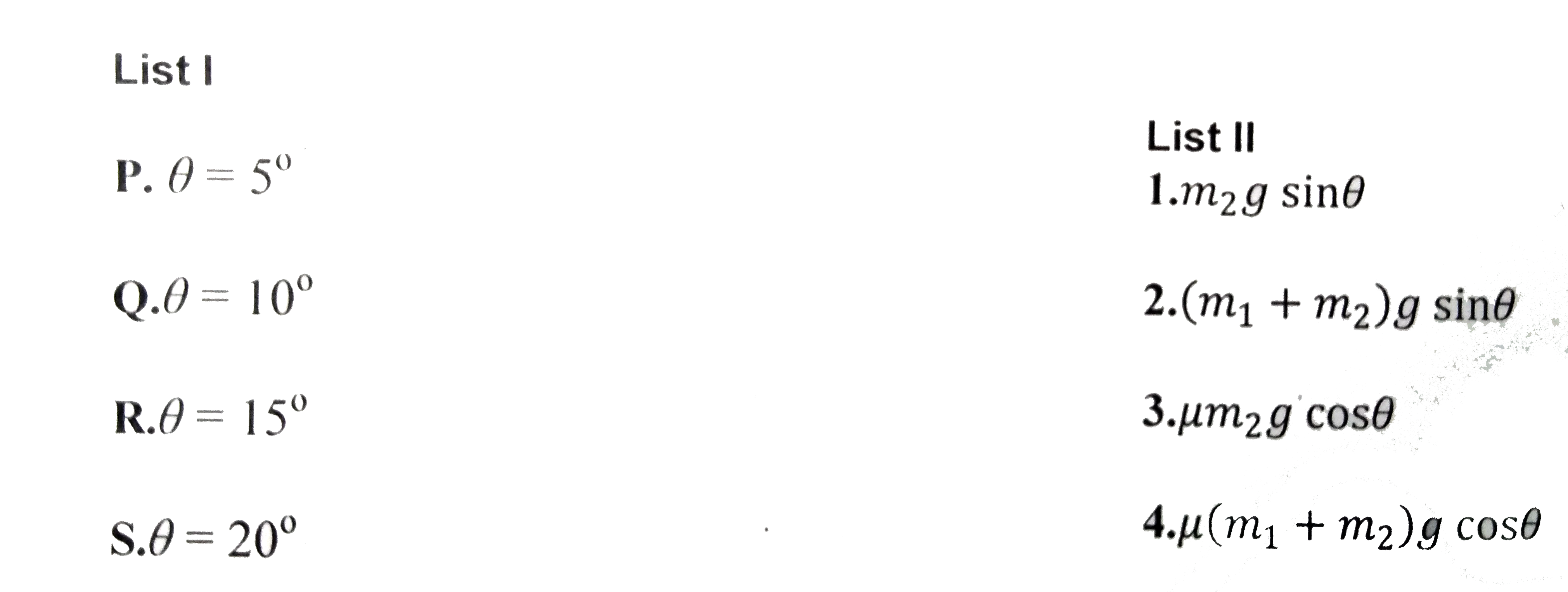Match the items mentioned in the lists I and II below
LIST -1
a) Static friction
b) Limiting friction
c) Kinetic friction
d) Rolling friction
LIST - II
e) constant for a given pair of surfaces
f) Independent of area of contact
g) Self adjusting
h) Has the least magnitude for a given normal reaction
a-e, b-f, c-g, d-h
a-h, b-f, c-e, d-g
a-g, b-e, c-f, d-h
a-g, b-h, c-f, d-e
The correct Answer is:C
Step by step video solution for Match the items mentioned in the lists I and II below LIST -1 a) Static friction b) Limiting friction c) Kinetic friction d) Rolling friction LIST - II e) constant for a given pair of surfaces f) Independent of area of contact g) Self adjusting h) Has the least magnitude for a given normal reaction by Physics experts to help you in doubts & scoring excellent marks in Class 11 exams.
Updated on:21/07/2023Similar Questions
Match List-I with List-II

View SolutionMatching block type
LIST - I
(a) Two rotating discs are brought in contact coaxially
(b) Contact force on a body placed in on rough surface
(c ) To continue a motion is easier than to initiate the motion
(d) For a Static friction less than limiting friction
LIST - II
(e ) Generated friction is equal to appliedexternal force in magnitude
(f) Loss of Rotational KE is transformed partly to heat
(g) The resultant of normal reaction and friction
(h) Kinetic friction is less than static friction
View SolutionA rod can rotate in a horizontal plane about its one end. A bead which can move along the rod is placed at certain distance from the axis or rotation. The bead does not to friction. The rod has a constant angular acceleration

A. the normal reaction on the bead will be constant h magnitude and direction both
B. the magnitude of the normal reaction on the bead will be variable
C. the magnitude of friction force on the bead will be constant
D. the magnitude of friction force on the bead will be variable
View SolutionMatch List - I (hypothetical reactions) with List - II (ratio KpKC for the given reactions) and select the correct answer using the code given below the lists

View SolutionA block of mass m1 = 1 kg another mass m2 = 2 kg, are placed together (see figure) on an inclined plane with angle of inclination θ. Various values of θ are given in List I. The coefficient of friction between the block m1 and the plane is always zero. The coefficient of static and dynamic friction between the block m2 and the plane are equal to μ=0.3 . In List II expressions for the friction on block m2 are given. Match the correct expression of the friction in List II with the angles given in List I, and choose the correct option. The acceleration due to gravity is denoted by g
[Useful information :tan(5.5∘)≈0.1,tan(11.5∘)≈0.2,tan(16.5∘)≈0.3].


View SolutionList-I List-II
a) Einstein e) velocity of light
b) Huygen f) diffraction of light
c) Focault g) wave nature of light
d) Fresnel h) particle nature of light
View SolutionConsider following statement
(A) Work done by pseudo force in non-inertial frame itself cannot be positive
(B) Net work done by static friction on the system (consisting surfaces I contact) is always zero
(C) Net work done by Kinetic friction on the system (consisting surfaces in contact) may be positive
(D) Work done by kinetic friction on a body may be positive
Select correct alternative :-
View SolutionA block of mass m1=1kg and another mass m2=2kg are placed together(see figure) on an inclined plane with angle of inclination θ varius value of θ are given in list 1 The coefficient of friction between the block m1 and the plank is always zero The coefficient of static and dynamic friction between the block m2 and the plank are equal to μ=0.3 In List II experssions for the friction the block m2 are given Match the correct experssions of the frictionless in List II with the angle given in list 1 and choice the correct option The acceleration due too gravity detented by g
[Useful information tan(5.5∘)=0.1tan(11.5∘)=0.2tan(16.5∘)=0.3]
List I P. θ=5∘ Q. θ=10∘
R. θ=15∘ S. θ=20∘
List 2
1.m2gsinθ 2.(m1+m2)gsinθ
3.μm2gcosθ 4. μ(m1+m2)gcosθ
View SolutionA block of mass m is kept over another block of mass M and the system rests on a horizontal surface. A constant horizontal force F acting on the lower block produces an acceleration F2(m+M) in the sytem. The two blocks always move together. Consider displacement d of the system.
a. Find the work done by friction on bigger block.
b. Find the coefficient of kinetic friction between the bigger block and the horizontal surface.
c. Find the frictional acting on the smaller block.
d. Find the work done by the force of friction on the smaller block by the bigger block.
e. Find the work done by static friction on bigger block.

View SolutionA block weighing 20N rests on a horizontal surface . The coefficient of static friction between the block and surface is 0.4 and the coeffiecient of kinetic frictioni 0.20
a.How much is the friction force excerted on the block?
b. How much will the friction force be if a horizontal force of 5N is exerted on the block?
c. What is the minimum force that will start the block in motion ?
d. What is the minimum force that will keep the block in motion once is has been started ?
e. If the horizontal force is 10N what is the friction force?
View Solution
